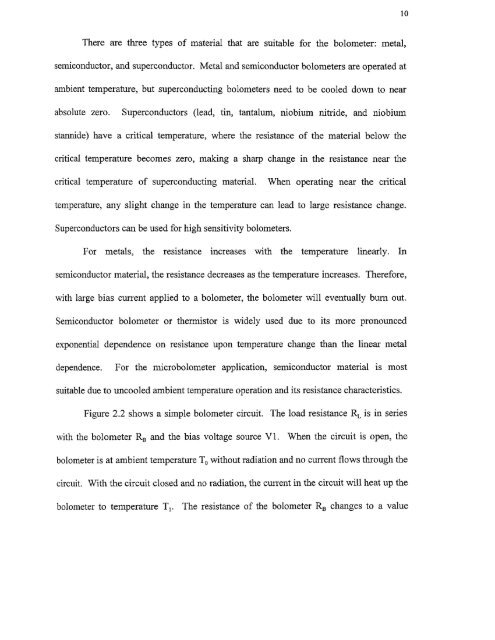Analysis of 320X240 uncooled microbolometer focal plane array ...
Analysis of 320X240 uncooled microbolometer focal plane array ...
Analysis of 320X240 uncooled microbolometer focal plane array ...
Create successful ePaper yourself
Turn your PDF publications into a flip-book with our unique Google optimized e-Paper software.
10There are three types <strong>of</strong> material that are suitable for the bolometer: metal,semiconductor, and superconductor. Metal and semiconductor bolometers are operated atambient temperature, but superconducting bolometers need to be cooled down to nearabsolute zero. Superconductors (lead, tin, tantalum, niobium nitride, and niobiumstannide) have a critical temperature, where the resistance <strong>of</strong> the material below thecritical temperature becomes zero, making a sharp change in the resistance near thecritical temperature <strong>of</strong> superconducting material. When operating near the criticaltemperature, any slight change in the temperature can lead to large resistance change.Superconductors can be used for high sensitivity bolometers.For metals, the resistance increases with the temperature linearly. Insemiconductor material, the resistance decreases as the temperature increases. Therefore,with large bias current applied to a bolometer, the bolometer will eventually bum out.Semiconductor bolometer or thermistor is widely used due to its more pronouncedexponential dependence on resistance upon temperature change than the linear metaldependence. For the <strong>microbolometer</strong> application, semiconductor material is mostsuitable due to <strong>uncooled</strong> ambient temperature operation and its resistance characteristics.Figure 2.2 shows a simple bolometer circuit. The load resistance R L is in serieswith the bolometer RB and the bias voltage source V1 . When the circuit is open, thebolometer is at ambient temperature To without radiation and no current flows through thecircuit. With the circuit closed and no radiation, the current in the circuit will heat up thebolometer to temperature T 1 . The resistance <strong>of</strong> the bolometer RB changes to a value
















